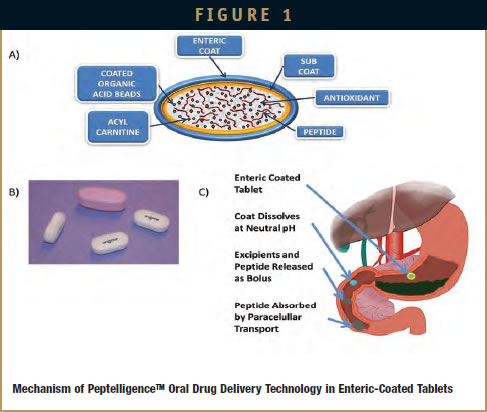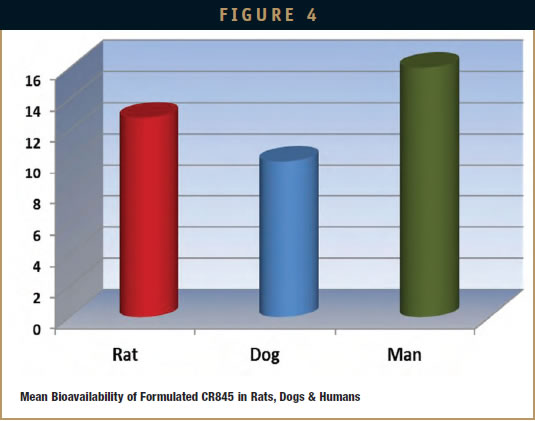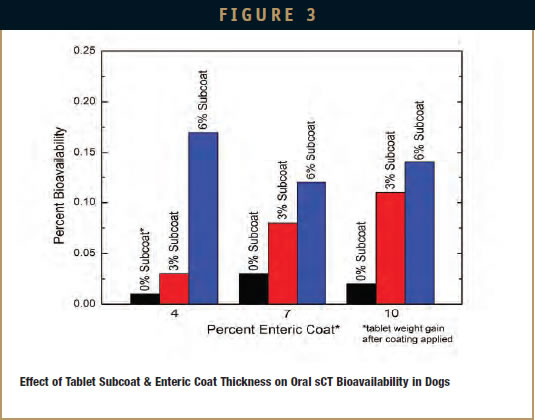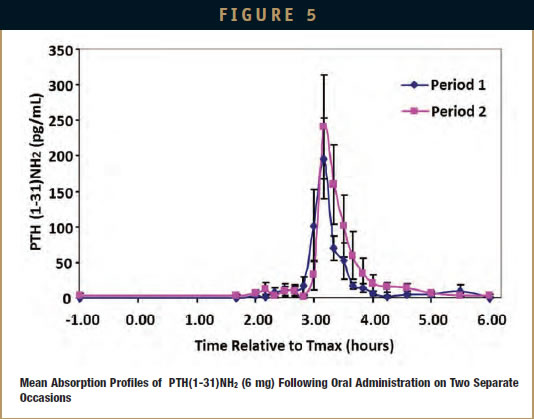Issue:March 2013
DRUG DELIVERY - Oral Delivery of Peptides by Peptelligence Technology
INTRODUCTION
PeptelligenceTM is a highly developed, clinically proven platform technology that enables the oral delivery of peptides. It overcomes the hurdles inherent to oral peptide delivery and has been clinically successful with multiple peptides, including a Phase I trial conducted by Cara Therapeutics for the kappa agonist, CR845, a Phase II trial of a PTH analog, and a pivotal Phase III trial for the oral delivery of salmon calcitonin (sCT).1-4 The obstacles to oral peptide delivery include 1) enzymatic and acid degradation in the stomach, 2) enzymatic degradation in the intestine, 3) an intestinal mucus barrier that prevents peptide diffusion, and 4) an intestinal lining of epithelial cells that resists peptide absorption. Unlike small molecule drugs, peptides are susceptible to hydrolysis, have an unfavorable partition coefficient for passive transcellular absorption, and are generally too large to be designed as substrates for influx transport systems. Furthermore, the molecular radius of peptides limits their ability to be absorbed through tight junctions between cells via simple, passive paracellular transport. In order to overcome these obstacles, a solid dosage form was developed that protects peptides from acid hydrolysis, enzymatic degradation, and also enhances paracellular transport. Figure 1A shows a cross-section of the tablet that was designed to fulfill each of these requirements.
The tablet consists of lyophilized peptide, coated organic acid granules (preferably citric acid), an acylcarnitine, an antioxidant (to prevent methionine and tryptophan oxidation), microcrystalline cellulose, a disintegrant, a dry binder, and a lubricant. These ingredients are dry blended and compressed into a tablet. The tablet core is then coated with a watersoluble polymer-based subcoat, followed by an acid-stable enteric-coating, which is designed to remain intact in the stomach and dissolve upon rise of the pH to above 5.5 in the duodenum.
The tablet weighs approximately 900 mg and is smaller than a widely used multivitamin tablet (Figure 1B). The coating of the organic acid granules forms a thin barrier that prevents acid degradation of the peptide in the tablet during storage. Peptides tested in these tablets have been found to be stable for at least 9 months at room temperature. Thus, the medication can be stored at room temperature once in the hands of the patient.
The tablet’s enteric coating allows it to pass through the stomach without releasing its contents (Figure 1C) and prevents food from affecting the peptide’s efficacy.5 Once the tablet is emptied into the duodenum, the neutral to alkaline liquid in the duodenum (Figure 1C) dissolves the enteric coating. The water-soluble undercoat sequesters the contents of the tablet core, allowing for complete and rapid enteric coat dissolution. Subcoat performance is a critical pharmaceutics design feature and acts to prevent the acid core from reducing the pH of the intestinal milieu and interfering with complete dissolution of the pH-sensitive enteric coat. Once the coatings dissolve, the tablet’s contents are rapidly released into the duodenum with the assistance of the disintegrant. The released citric acid granules rapidly dissolve and quickly reduce intestinal pH transiently in this localized microenvironment. This in turn prevents degradation of the peptide by intestinal proteases and peptidases, which generally have a neutral to alkaline pH optimum.
The simultaneous release of the acylcarnitine, preferably lauroyl-L-carnitine (LLC), enhances peptide absorption by increasing passive paracellular transport. LLC acts by transiently loosening tight junctional complexes, resulting in a net increase in the paracellular pore radius between adjacent gastrointestinal epithelial cells (Figure 1C).
PRECLINICAL DEVELOPMENT
Early in vivo studies with anesthetized rats demonstrated that the bioavailability of salmon calcitonin (sCT), a peptide composed of 32 naturally occurring L-amino acids, could be increased 32-fold by lowering the vehicle pH, when administered by direct intraduodenal injection into rats.6 By varying the ratio of citric acid and sodium citrate to control the vehicle pH, the bioavailability of sCT increased from 0.02% at pH 5 to 0.64% at pH 3 and to 0.69% at pH 2. A similar observation was made in dogs equipped with modified vascular access ports that were implanted into the duodenum of male beagles.6,7 The inclusion of citric acid in the vehicle injected through the port into the duodenum increased the absolute bioavailability of sCT in dogs 25-fold from 0.015% to 0.37%.
In addition to inhibiting intestinal proteases, it was found in vitro that the addition of agents that reversibly increased intestinal permeability could also improve the bioavailability of sCT. The permeability of rat jejunal tissue to sCT in diffusion chambers increased up to 5- and 14-fold in the presence of 1% LLC and 1% sodium taurodeoxycholate, respectively, and to a lesser extent in the presence of other enhancers.7 This change was accompanied by a decrease in transepithelial electrical resistance (TEER) of intact tissue, a measure of tight junction permeability and resistance to the paracellular transport of ions.7 Importantly, from a drug safety perspective, upon removal of these enhancers, TEER returned to near baseline values within 10 minutes.7
In vivo, the bioavailability of sCT administered with LLC directly into the duodenum of anesthetized rats increased from 0.096% to 0.17% which further increased to 4.53% when citric acid was also included in the formulation.6 In dogs equipped with modified vascular access ports attached to the duodenum, the bioavailability of sCT in a solution containing citric acid increased from 0.37% to 0.81%, when taurodeoxycholic acid was added to the formulation.6 The in vivo results indicated that the inclusion of an enhancer in the formulation was not sufficient to significantly increase the “oral” bioavailability of sCT without the addition of a pH-modifying agent as a protease inhibitor. This observation was confirmed with beagle dogs that were orally administered entericcoated capsules containing sCT, LLC, and increasing amounts of citric acid (up to 565 mg/capsule). The absolute bioavailability of sCT in the presence of LLC and no citric acid was 0.02%, which increased to 0.86% in the presence of 565 mg of citric acid.8 By tethering sCT containing capsules with surgical string to Heidelberg capsules, which transmit pH by radio telemetry, it was possible to monitor intestinal pH at the time the enteric-coated capsules released their contents. The resulting pH and sCT absorption profile is shown in Figure 2. The first decrease in pH is caused by capsule residence in the stomach. When the capsule entered the duodenum, the pH increased to between 6 and 7. As the capsule dissolved in the duodenum, the pH decreased to 3 because citric acid was released. At the same time the pH decreased, the concentration of sCT in plasma increased. It should be noted that thereafter, the pH rapidly increased to 7, which indicates that the decrease in pH resulting from citric acid release is transient and rapidly reversible.
In addition to the inclusion of an acid and enhancer to the tablet core, it was found that the thickness and composition of the subcoat and the enteric coat had a significant effect on the bioavailability of the tablet formulation. Using sCT as a model peptide in LLC-free tablets containing CA, experiments were carried out to determine the optimal thickness (expressed as the percent weight gain of the tablet after coating) of subcoat and enteric coat on sCT bioavailability. As shown in Figure 3, in the absence of the subcoat, the bioavailability of sCT was 0.01% for tablets coated with a 4% enteric coat. The bioavailability increased to 0.03% and 0.02% for tablets coated with 7% and 10% enteric coat, respectively. The inclusion of a watersoluble non-ionic polymer as a subcoat increased the bioavailability of sCT up to 17- fold to 0.17%.
Using an approach similar to the development of enteric-coated capsules and tablets for sCT, studies were undertaken with several other sponsors or partners to determine if a formulation containing citric acid and LLC would improve the oral bioavailability of other peptides in development for therapeutic use. Peptides ranging in size from 4 to 39 amino acids and exhibiting a range of physico-chemical properties were tested in rat and dog models. The peptides were initially tested in anesthetized rats by injecting peptide into the duodenum in a formulation-free solution (unformulated peptide) or in a solution containing buffered CA and LLC (formulated peptide). This intra-duodenal delivery procedure is designed to mimic an entericcoated tablet formulation that would pass through the stomach intact and dissolve and release its contents in the duodenum. Under these conditions, the bioavailability of unformulated peptides ranged from 0.35% to 6.0%, whereas the bioavailability of peptides that were formulated with citrate buffer and LLC was significantly increased to as high as 29%. The peptides were then tested in beagle dogs with either enteric-coated capsules containing a blend of peptide and inert filler, such as microcrystalline cellulose (unformulated) or a blend of peptide with citric acid and LLC (formulated). Under these conditions the bioavailability of unformulated peptides ranged from undetectable to 0.38%, whereas the bioavailability of peptides that were formulated with citric acid and LLC increased up to 22.8%. In all cases, the bioavailability of the formulated peptide was significantly enhanced compared to that of the unformulated peptide. As expected, the absolute bioavailability depended largely on the size, charge, hydrophobicity, and stability of the peptide being tested.
CLINICAL STUDIES
Figure 4 summarizes the results of feasibility studies in rats and dogs that culminated in a Phase I clinical trial. The bioavailability of formulated CR845, a kappa opioid receptor peptide agonist, in rats and dogs was greater than 10%. The results in dogs were deemed to be encouraging enough by the sponsor, Cara Therapeutics, to test the formulation in humans. In an oral Phase I study, 50 individuals were randomized to receive either placebo or one of four single ascending doses of an enteric-coated, capsule formulation of CR845 using the PeptelligenceTM technology. The mean oral bioavailability was 16% across all groups under fasted conditions, with peak and total exposures proportional to each dose. Peripheral kappa opioid receptor activation was seen at all doses tested as measured by a standard biomarker. Orally administered CR845 did not produce any dysphoric or psychomimetic side effects and appeared to be safe and generally well tolerated across all doses tested.1
As part of a two-period clinical study, PeptelligenceTM was used to orally deliver a 6- mg dose of PTH(1-31)NH2 to postmenopausal women.9 This two-period replicate dose pharmacokinetic (PK) study was carried out to evaluate the safety as well as the inter- and intra-subject variability of delivering 6-mg PTH(1-31)NH2 to postmenopausal women. Blood samples were collected over a 6-hour period following dosing, and PTH levels were quantified using a specific sandwich ELISA. The mean Cmax values were in the 200 to 300 pg/mL range, and hence achieved or exceeded blood levels that have been shown to be anabolic with an existing injectable formulation. The PK profiles were consistent with the requirement for bone anabolic activity, with an elimination t½ of 13 to 21 minutes. The study also demonstrated low inter- and intra-subject variability (Figure 5). In a subsequent Phase II clinical trial, PeptelligenceTM was used to test the bone anabolic efficacy of orally administered PTH(1-31)NH2. The study was a 24-week double blind, randomized, repeat dose parallel group study of rhPTH(1-31)NH2, or placebo tablets, compared to open label Forsteo® (teriparatide) in 97 postmenopausal women with osteoporosis. The primary endpoint was to characterize percent change from baseline in bone mineral density (BMD) at lumbar spine (LS) after 24 weeks of once-daily oral treatment with 5 mg PTH(1-31)NH2. The trial met the primary endpoint with an increase of 2.2% in LS BMD with PTH(1-31)NH2 compared to baseline (p < 0.001). This study also showed consistent exposure of the PTH(1-31)NH2 at the beginning and end of the study [week 0 and week 24].2,3,10
The clinical efficacy of PeptelligenceTM technology has been further validated by a Phase III non-inferiority trial comparing oral calcitonin to an approved nasal calcitonin spray for the treatment of postmenopausal osteoporosis.4 A total of 565 women aged 46 to 86 years were randomized to receive oral recombinant salmon calcitonin (rsCT) tablets (0.2 mg/day), synthetic salmon calcitonin (ssCT) nasal spray (200 IU/day), or placebo, respectively for 48 weeks. Although no PK measurements were carried out in this study, the efficacy of orally delivered sCT was demonstrated by the finding that women randomized to oral rsCT had a mean 1.53% increase from baseline in LS BMD that was greater than those randomized to ssCT nasal spray (0.78%) or placebo (0.47%). Oral rsCT treatment also resulted in greater improvements in trochanteric and total proximal femur BMD than ssCT nasal spray. It is also of interest that oral sCT resulted in significantly fewer women having anti-sCT antibodies than women receiving nasal sCT (6.5% versus 32.5%, p < 0.001).4 Oral rsCT was safe and as well tolerated as ssCT nasal spray or placebo.
CONCLUSIONS
The results from multiple preclinical as well as early and late-stage clinical studies have demonstrated the applicability of PeptelligenceTM to the oral delivery of peptides. As mentioned earlier, the absolute bioavailability achieved largely depends on the physicochemical properties of the peptide, such as size, charge, stability, and hydrophobicity. The use of enteric-coated capsules or tablets minimizes food effects or dilution effects due to large volumes of simultaneously imbibed liquids. This has been recently demonstrated in a Phase II study investigating sCT for the treatment of osteopenia, where it was demonstrated that the percent increase in LS BMD was equivalent whether the tablet was administered to the patient with a meal, or at bedtime.4 This clinically proven technology will increase patient acceptance and compliance for chronically administered drugs. It also expands the market for drugs that are or would be niche products if administered by daily injections, and offers the potential for life cycle management of older injectable products.
REFERENCES
1. Cara Therapeutics Successfully Completes Phase I Study With Oral Formulation of Its Novel Kappa Opioid Receptor Agonist, CR845. Website: http://www.caratherapeutics.com/cr845-phase1-complete-release.shtml.
2. Mehta N, Karsdal M, Tavakkol R, Stern W, Sturmer A, Mitta S, Henriksen K, Andersen J, Riis B, Alexandersen P, Valter I, Nedergaard B, Teglbjaerg C , Nino A, Fitzpatrick L, Christiansen C, Cosman F. A phase 2 randomized trial of orally administered PTH(1-31)NH2 tablets in postmenopausal women with osteoporosis. Paper presented at: ASBMR 2012 Annual Meeting, October 12-15, 2012, in Minneapolis, MN.
3. Henriksen K, Andersen JR, Riis BJ, Mehta N, Tavakkol R, Alexandersen P, Valter I, Nedergaard BS, Teglbjærg CS, Stern W, Sturmer A, Mitta S, Nino AJ, Fitzpatrick LA, Christiansen C, Karsdal MA. Evaluation of the efficacy, safety and pharmacokinetic profile of oral recombinant human parathyroid hormone [rhPTH(1-31)NH2] in postmenopausal women with osteoporosis. Bone. 2012 Dec 9. doi:pii: S8756-3282(12)01408-1. 10.1016/j.bone.2012.11.045. [Epub ahead of print].
4. Binkley N, Bolognese M, Sidorowicz- Bialynicka A, Vally T, Trout R, Miller C, Buben CE, Gilligan JP, Krause DS. Oral calcitonin in postmenopausal osteoporosis (ORACAL) investigators: a phase 3 trial of the efficacy and safety of oral recombinant calcitonin: the oral calcitonin in postmenopausal osteoporosis (ORACAL) trial. J Bone Miner Res. 2012;27(8):1821- 1829.
5. Binkley N, Bone H, Bolognese M, Krause D. Safety and efficacy of orally administered recombinant salmon calcitonin tablets in the prevention of postmenopausal osteoporosis in women with low bone mass: a phase 2 placebo-controlled trial. Paper presented at: ASBMR 2012 Annual Meeting, October 12-15, 2012, in Minneapolis, MN.
6. Stern W, Gilligan J. Unigene Laboratories, Inc. (1999). Oral Salmon Calcitonin Pharmaceutical Products. US Patent No. 5,912,014.
7. Sinko PJ, Lee YH, Makhey V, Leesman GD, Sutyak JP, Yu H, Perry B, Smith CL, Hu P, Wagner EJ, Falzone LM, McWhorter LT, Gilligan JP, Stern W. Biopharmaceutical approaches for developing and assessing oral peptide delivery strategies and systems: in vitro permeability and in vivo oral absorption of salmon calcitonin (sCT). Pharm Res. 1999;16(4):527-533.
8. Lee YH, Perry BA, Labruno S, Lee HS, Stern W, Falzone LM, Sinko PJ. Impact of regional intestinal pH modulation on absorption of peptide drugs: oral absorption studies of salmon calcitonin in beagle dogs. Pharm Res. 1999;16(8):1233-1239.
9. Mehta N, Tavakkol R, Erickson K, Stern B, Gilligan J, Fein S, Mitta S, Sturmer A, Shields P, Rasums A, Fitzpatrick L. Clinical development of an orally delivered recombinant PTH analog. Paper presented at: ASBMR 2011 Annual Meeting, September 16-20, 2011, in San Diego, CA.
10. Sturmer A, Stern W, Giacchi J, Bolat A, Mitta S, Tavakkol R, Trang J, Wald J, Fitzpatrick L, Mehta N. Pharmacokinetic results of a phase 2 clinical study of an oral tablet formulation of PTH(1-31)NH2. Poster presented at: ASBMR 2012 Annual Meeting, October 12-15, 2012, in Minneapolis, MN.

Dr. William Stern is a Senior Director of Formulation Development at Unigene Laboratories, Inc. in Fairfield, NJ. He earned his BA in Chemistry from New York University in 1967 and a PhD in Biochemistry from the University of Michigan in 1972. Subsequently, he joined the research staff of the Public Health Research Institute of the City of New York, where he isolated and identified the neutralizing antigen for vaccinia virus. Since 1986, he has been with Unigene Laboratories, Inc. He was the lead scientist in the development of Unigene’s first commercial product, Fortical®, is the inventor of Unigene’s nasal peptide technology, and an inventor of PeptelligenceTM technology.

Dr. Nozer Mehta earned his Masters from the University of Mumbai, India, and a Doctorat d’Université (equivalent to the PhD) with Honors from the Université Louis Pasteur in Strasbourg, France. He has worked as a staff scientist at the Cancer Research Institute in Mumbai and as a research assistant professor at the University of Nebraska in Lincoln. Dr. Mehta joined Unigene in 1982. He has played a key role in developing Unigene’s therapeutic programs and platform technologies and is an inventor on several key Unigene patents. As the Chief Scientific Officer at Unigene, he oversees the scientific research and development of Unigene’s therapeutic programs.

Dr. Stephen M. Carl is currently an Associate Director of Formulation Development at Unigene Laboratories, Inc., where he has been working on new formulation techniques as applied to oral peptide delivery. Prior to joining Unigene, Dr. Carl worked at Baxter Healthcare for 6 years in drug stability and analytical research. Dr. Carl completed his doctorate in Industrial and Physical Pharmacy with a focus on Biopharmaceutical Sciences, from Purdue University. He has published and presented multiple articles in national and international journals and conferences.
Total Page Views: 8121






















